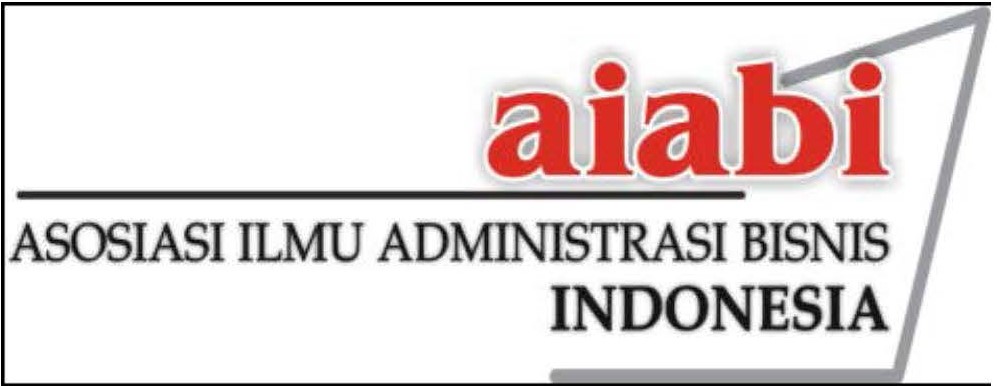STATE-OF-THE-ART DIGITAL ENTREPRENEURSHIP DALAM BISNIS KELUARGA: ANALISIS CO-AUTHORSHIP DAN CO-OCCURRENCE
Abstrak
There are still few in family business studies that discuss the topic of digipreneurship, even though digipreneurship is important for continuity and growth of companies in today's business world. Therefore, the aim of this study is to uncover the state-of-the-art and create research gaps in the literature related to digipreneurship in family business. For this purpose, a bibliometric study using co-authorship and key word co-occurrence analysis conducted in the Scopus database. The results of the co-authorship analysis show that the cohesiveness of collaboration in exploring digipreneurship in family business has been achieved at the state level in the 2017-2020 period, but at the author and organizational level has not been achieved. This indicates that the study of digipreneurship in family business is in early stages of growth. The results of the co-occurrence keyword analysis show that there are three specific domains in the field, namely digital transformation of entrepreneurial-oriented family firms; entrepreneurial knowledge management and digital capabilities in the family business; and transgenerational entrepreneurship in the digital era; Another domain that is important to be developed but has not been identified and has become a research gap is the value chain and internal processes in digipreneurship in family business.
Penelitian bisnis keluarga sampai saat ini belum banyak yang membahas topik digipreneurship, padahal digipreneurship penting untuk keberlangsungan dan pertumbuhan perusahaan di dunia bisnis saat ini. Karena itu, tujuan penelitian ini adalah untuk mengungkap state-of-the-art dan memunculkan kesenjangan penelitian dalam literatur terkait dengan digipreneurship dalam bisnis keluarga. Untuk tujuan tersebut, Penulis melakukan penelitian bibliometrik dengan metode analisis co-authorship dan analisis co-occurrence kata kunci pada basis data Scopus. Hasil analisis co-authorship menunjukkan bahwa kohesivitas kolaborasi dalam mengekplorasi digipreneurship dalam bisnis keluarga sudah tercapai di tingkat negara dalam rentang tahun 2017-2020, namun kohesivitas co-authorship di tingkat penulis dan organisasi belum tercapai. Kondisi demikian mengindikasikan bahwa kajian digipreneurship dalam bisnis keluarga masih berada dalam fase awal tumbuh. Hasil analisis co-occurrence kata kunci menunjukkan bahwa ada tiga domain yang khas dalam publikasi ilmiah digipreneurship dalam bisnis keluarga yaitu transformasi digital perusahaan keluarga berorientasi entrepreneurial, manajemen pengetahuan entrepreneurial dan kapabilitas digital dalam bisnis keluarga, dan entrepreneurship transgenerasi pada era digital; Domain lain yang penting untuk dikembangkan namun belum teridentifikasi dan menjadi kesenjangan dalam penelitian ini adalah domain rantai nilai dan proses internal pada digipreneurship dalam bisnis keluarga.
Kata Kunci
Teks Lengkap:
PDFReferensi
Aldrich, H.E. & Cliff, J.E. (2003). The pervasive effects of family on entrepreneurship: Toward a family embeddedness perspective. Journal of Business Venturing, 18(5), pp. 573-596
Alsos, G. A., Carter, S. & Ljunggren, E. (2014) Kinship and business: how entrepreneurial households facilitate business growth. Entrepreneurship & Regional Development, 26:1-2, 97-122.
Arregle, J. L., Hitt, M. A., Sirmon, D. G., & Very, P. (2007). The development of organizational social capital: Attributes of family firms. Journal of Management Studies, 44(1), pp. 73-95
Asghari, R., & Gedeon, S. (2010). Significance and impact of Internet on the entrepreneurial process: E-entrepreneurship and completely digital entrepreneurship. In A. Kakouris (Ed.), Proceedings of the 4th European Conference on Innovation and Entrepreneurship (pp. 70–76). Academic Publishing Limited.
Astrachan, J. H., Zahra, S. A., & Sharma, P. (2003). Family-sponsored ventures. Kansas, MO: Kauffman Foundation.
Basly, S. & Hammouda, A. (2020). Family Businesses and Digital Entrepreneurship Adoption: A Conceptual Model. Journal of Entrepreneurship, 29(2), pp. 326-364
Bobillo, A. M., Rodríguez-Sanz, J. A., & Tejerina-Gaite, F. (2013). Shareholder activism and internationalization in the family firm. Journal of Business Economics and Management, 14(5), 867–885.
Brannon, D. L., Wiklund, J., & Haynie J. M. (2013). The Varying Effects of Family Relationships in Entrepreneurial Teams. Entrepreneurship Theory and Practice, 37(1), 107-132
Cabrera-Suárez, M. K., & Martín-Santana, J. D. (2012). Successor's commitment and succession success: dimensions and antecedents in the small Spanish family firm. The International Journal of Human Resource Management, 23(13), 2736-2762.
Cabrera-Suárez, M. K., García-Almeida, D. J., & De Saá-Pérez, P. (2018). A dynamic network model of the successor’s knowledge construction from the resource-and knowledge-based view of the family firm. Family Business Review, 31(2), 178-197.
Coulson-Thomas, C. (2003). The knowledge entrepreneur: How your business can create, manage and profit from intellectual capital. Kogan Page Publishers.
Coulson-Thomas, C. (2004). The knowledge entrepreneurship challenge: Moving on from knowledge sharing to knowledge creation and exploitation. The Learning Organization, 11(1), 84.
Cruz, R. Justo, J. O., & De Castro (2012). Does family employment enhance MSEs performance? Integrating socioemotional wealth and family embeddedness perspectives. Journal of Business Venturing, 27 (1) (2012), pp. 62-76
Cech, F. (2017). Exploring Emerging Topics in Social Informatics: An Online Real-Time Tool for Keyword Co-Occurrence Analysis. In International Conference on Social Informatics (pp. 527-536). Springer, Cham. September
Chang, H. J., & Wang, W. M. (2017). The Hidden Power of Social-Linkage in the Office: A Co-authorship Network Analysis. In Proceedings of the 4th Multidisciplinary International Social Networks Conference (pp. 1-6).
Chun-xiao, Z., Yao, L., Yang, W., Ya-fei, Y., Xiao, H., & Ya-juan, Z. (2020). Research status of transportation field based on keyword co-occurrence analysis. In IOP Conference Series: Earth and Environmental Science (Vol. 587, No. 1, p. 012093). IOP Publishing.
Craig, J. B., & Moores, K. (2006). A 10-year longitudinal investigation of strategy, systems, and environment on innovation in family firms. Family Business Review, 19(1), 1-10.
Criaco, G., Sieger, P., Wennberg, K., Chirico, F., & Minola, T. (2017). Parents’ performance in entrepreneurship as a “double-edged sword” for the intergenerational transmission of entrepreneurship. Small Business Economics, 49(4), 841-864.
Davidson, E., & Vaast, E. (2010). Digital entrepreneurship and its sociomaterial enactment [Paper presentation]. Proceedings of the Annual Hawaii International Conference on System Sciences, Honolulu, HI, USA. January 5–8.
de Oliveira, O. J., da Silva, F. F., Juliani, F., Barbosa, L. C. F. M., & Nunhes, T. V. (2019). Bibliometric Method for Mapping the State-of-the-Art and Identifying Research Gaps and Trends in Literature: An Essential Instrument to Support the Development of Scientific Projects. In Scientometrics Recent Advances. IntechOpen.
Discua Cruz A, Howorth C, & Hamilton E. (2013). Intrafamily Entrepreneurship: The Formation and Membership of Family Entrepreneurial Teams. Entrepreneurship Theory and Practice. 37(1):17-46.
Edelman, L. F., Manolova, T., Shirokova, G., & Tsukanova, T. (2016). The impact of family support on young entrepreneurs' start-up activities. Journal of Business Venturing, 31(4), 428-448.
Ensley, M. D., & Pearson A. W. (2005). An Exploratory Comparison of the Behavioral Dynamics of Top Management Teams in Family and Nonfamily New Ventures: Cohesion, Conflict, Potency, and Consensus. Entrepreneurship Theory and Practice. 2005;29(3):267-284.
Fernández, Z., & Nieto, M. J. (2006). Impact of ownership on the international involvement of SMEs. Journal of International Business Studies, 37(3), 340–351.
Gao, P., Zhao, J., & Li, X. (2019). Keyword Co-occurrence Analysis of Research on Innovation Ecosystem Studies. Economic Management Journal, 8(2).
Goel S, Jones RJ. (2016). Entrepreneurial Exploration and Exploitation in Family Business: A Systematic Review and Future Directions. Family Business Review. 2016;29(1):94-120.
Guan, Y., Kang, R., & Liu, J. (2019). Evolution of the field of ecological restoration over the last three decades: a bibliometric analysis. Restor. Ecol. 27, 647e660.
Gudmundson, D., Tower, B. C., & Hartman, A. E. (2003). Innovation in small businesses: Culture and ownership structure do matter. Journal of Developmental Entrepreneurship, 8(1), 1–17.
Gurbaxani, V., & Dunkle, D. (2019). Gearing up for successful digital transformation. MIS Quarterly Executive, 18(3), 209–220
Ivanov, I.I. (2019). Chasing the Crowd: Digital Transformations and the Digital Driven System Design Paradigm. Lecture Notes in Business Information Processing, 356:64-80.
Jennings, J. E., Eddleston, K. A., Devereaux Jennings, P., & Sarathy, R. (2015). Introduction: A framework for studying the 'double embeddedness' of business enterprising. Firms within Families: Enterprising in Diverse Country Contexts, pp. 1-12
Kraus, S., Roig-Tierno, N., & Bouncken, R. B. (2019). Digital innovation and venturing: An introduction into the digitalization of entrepreneurship. Review of Managerial Science, 13(3), 519–528.
Laborde, O. (2014). Ce que transformation digitale veut vraiment dire. Harvard Business Review France. https://www.hbrfrance.fr/chroniquesexperts/2017/09/16683-transformation-digitale-veut-vraiment-dire/
Lancaster, K. (1975). The theory of household behaviour. Some foundations. Annals of economic and social measurement. Vol 4 (1), 5-21.
Leal, A. I., Correia, R. A., Palmeirim, J. M., & Bugalho, M. N. (2019). Is research supporting sustainable management in a changing world? Insights from a Mediterranean silvopastoral system. Agrofor. Syst. 93, 355e368.
Letonja, M., & Duh, M. (2016). Knowledge transfer in family businesses and its effects on the innovativeness of the next family generation. Knowledge Management Research & Practice, 14(2), 213-224.
Llach, J., & Nordqvist, M. (2010). Innovation in family and non-family businesses: A resource perspective. International Journal of Entrepreneurial Venturing, 2(3/4), 381.
McFalls Jr., J.A. (2007). Population: A lively introduction. Population Bulletin, 62 (1), 3-31
Miller, D., Steier, L., & Le Breton-Miller, I. (2003). Lost in time: Intergenerational succession, change, and failure in family business. Journal of business venturing, 18(4), 513-531.
Mongeon, P., & Paul-Hus, A. (2016). The journal coverage of Web of Science and Scopus: a comparative analysis. Scientometrics, 106(1), 213-228.
Mulet-Forteza, C., Genovart-Balaguer, J., Mauleon-Mendez, E., & Merigó, J. M. (2019). A bibliometric research in the tourism, leisure and hospitality fields. Journal of Business Research, 101, 819-827.
Nambisan, S. (2017). Digital entrepreneurship: Toward a digital technology perspective of entrepreneurship. Entrepreneurship Theory and Practice, 41(6), 1029–1055.
Nonaka, I., Toyama, R., & Konno, N. (2000). SECI, Ba and leadership: a unified model of dynamic knowledge creation. Long range planning, 33(1), 5-34.
Paramsothy, V., Woods, P., & Raman, M. (2013). Success factors for implementation of entrepreneurial knowledge management in Malaysian banks. Journal of Information & Knowledge Management, 12(02), 1350015.
Powell, G. N., & Eddleston, K. A. (2017). Family involvement in the firm, family‐to‐business support, and entrepreneurial outcomes: An exploration. Journal of Small Business Management, 55(4), 614-631.
Purnomo, M., Maulana, Y. S., Sugiartana, & Tjahjono, E. (2020). State Of The Art Crowfunding Dalam Konteks Keuangan Entrepreneurial (Studi Pemetaan Sistematis dan Analisis Co-authorship Pada Basis Data Scopus). AdBispreneur: Jurnal Pemikiran dan Penelitian Administrasi Bisnis dan Kewirausahaan, 5(1), 89-116.
Raman, A. (2016). How Do Social Media, Mobility, Analytics and Cloud Computing Impact Nonprofit Organizations? A Pluralistic Study of Information and Communication Technologies in Indian Context. Information Technology for Development, 22(3): 400-421
Randerson, K., Bettinelli, C., Fayolle, A., & Anderson, A. (2015). Family entrepreneurship as a field of research: Exploring its contours and contents. Journal of Family Business Strategy, 6(3), 143-154.
Rodriguez, P., Tuggle, C. S., & Hackett, S. M. (2009). An Exploratory Study of How Potential “Family and Household Capital” Impacts New Venture Start-Up Rates. Family Business Review. 22(3):259-272.
Schjoedt, L., Monsen, E., Pearson, A., Barnett, T., & Chrisman, J. J. (2013). New Venture and Family Business Teams: Understanding Team Formation, Composition, Behaviors, and Performance. Entrepreneurship Theory and Practice. 37(1):1-15.
Sciascia, S., & Bettinelli, C. (2013). Corporate entrepreneurship in family businesses: Past, present and future research. M@n@gement, 16(4), 422-432.
Sharma, P., Chrisman, J. J., & Chua, J. H. (2003). Predictors of satisfaction with the succession process in family firms. Journal of business Venturing, 18(5), 667-687.
Sieger, P., & Minola, T. (2017). The family's financial support as a “poisoned gift”: A family embeddedness perspective on entrepreneurial intentions. Journal of Small Business Management, 55(sup1), 179-204.
Steier L. (2009). Where Do New Firms Come From?: Households, Family Capital, Ethnicity, and the Welfare Mix. Family Business Review. 2009;22(3):273-278.
Strategic Policy Forum on Digital Entrepreneurship. (2014). Fueling digital entrepreneurship in Europe. Background paper, European Commission, 6 p.
The Guardian. (2017). Digital transformation. https://www.theguardian.com/media-network/media-network-blog/2013/nov/21/digital-transformation
Tumbas, S., Berente, N., Seidel, S., & VomBrocke, J. (2015). The “digital façade” of rapidly growing entrepreneurial organizations [Paper presentation]. 2015 International Conference on Information Systems: Exploring the Information Frontier (ICIS 2015), Fort Worth, TX, USA.
Van Eck, N. J., & Waltman, L. (2019). Manual for VOSviewer version 1.6. 10. Leiden: CWTS Universiteit Leiden.
Ward, J. L. (2011). Keeping the family business healthy: How to plan for continuing growth, profitability, and family leadership. Palgrave Macmillan.
Welter F. (2011). Contextualizing Entrepreneurship—Conceptual Challenges and Ways Forward. Entrepreneurship Theory and Practice. 35(1):165-184.
Westhead, P. (1997). Ambitions, external environment and strategic factor differences between family and non-family companies. Entrepreneurship & Regional Development, 9(2), 127–158.
Xiang, C., Wang, Y., & Liu, H. A (2017). Scientometrics review on nonpoint source pollution research. Ecol. Eng, 99, 400–408
Zenko, Z., & Mulej, M. (2011). Diffusion of innovative behaviour with social responsibility. Kybernetes, 40(9/10), 1258.
Zhang, J., Ding, G., Zou, Y., Qin, S. & Fu, J. (2019). Review of job shop scheduling research and its new perspectives under Industry 4.0. Journal of Intelligent Manufacturing, 30(4): 1809-1830.
DOI: https://doi.org/10.24198/adbispreneur.v6i1.31103
Refbacks
- Saat ini tidak ada refbacks.









